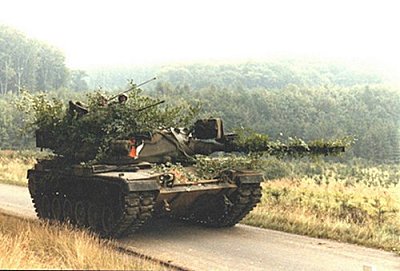
Autumn Forge, Sept. 1978... cont.
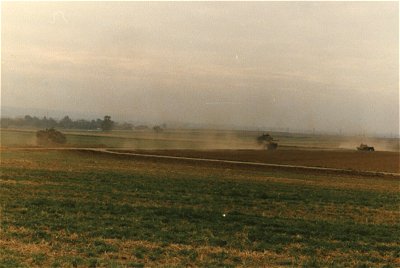
As the attack once more picks up, tanks and mechanized vehicles move quickly across open spaces to close with the fleeing enemy. Sometimes they pass German farmers attempting to work on their fields (at right). Naturally, these are ignored as the column presses on.
During this stage of the exercise the weather is fair, and the ground is hard and dry, making cross-country motoring nearly as rapid as using the "hard balls" and "candy stripes" (knicknames for hard-surfaced roads, based on their map symbols). Tanks usually stay low in the terrain, but if opposition is light they may move cross country in wedge or line abrest formation in order to apply rapid and overwhelming firepower at the point of attack. Here M-60a1s use rapid "short halts" to engage enemy mech infantry elements withdrawing before them. The short halt is a technique of gunnery which is used when firing on the move is not. In this technique, the tank quickly rolls to a halt, engages a target, then immediately moves out, often shifting side to side to throw off the aim of enemy gunners.
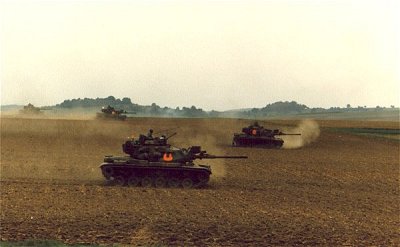
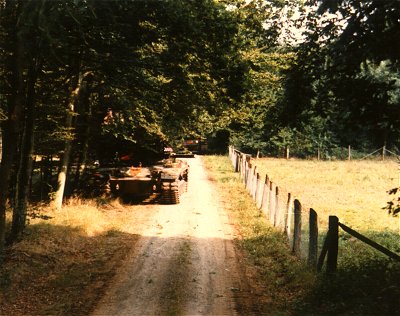
Once again the TF tanks are forced to hide as enemy helicopters search for them. Overhead cover is essential to combat survival when enemy air is operating in an area.
When the left hand photo was shot, several "enemy" gunships were at that moment skimming the woods in search of our vehicles. They finally found some of them, and 2nd Platoon of B Co. became casualites of helocopter wire guided missiles, thereby earning the infamous yellow nerf ball!
The platoon tanks were herded into a wooded area, where crews pulled desperately needed maintenance while waiting to be "reactivated" and sent once more into the battle.
While awaiting our return to battle, the skies opened and the rain came down. With the weather deteriorating, visibility was cut down to less than 300 meters. Today, thermal imagers can help cut through this, but it wasn't too long ago when such weather would bring tank engagements to incredibly close encounters. In such actions, turret rotation speed becomes a crucial factor.
Left: M-551 Sheridans of the 5th Infantry Division (the Red Diamonds) conducting a passage of lines. This unit deployed out of Ft. Polk, LA for the exercise.
Speaking of the Sheridan......Occasionally, participants in maneuvers can become too involved and take things a bit too seriously. One sergeant had an incident when operating an M-551 Sheridan recon tank (left). An M-113 personal carrier (often called a "track") tried to block the road before him, and the Sheridan commander rammed the track! He then jumped from the TC hatch, .45 in hand, and shoved it into the face of the shocked commander of the 113.
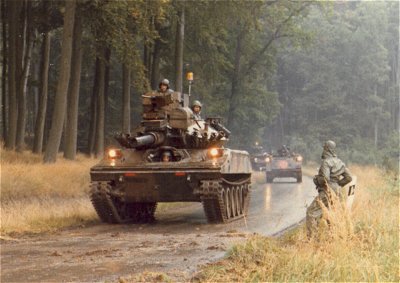
Reactivated as a "reserve" force, 2nd plt with a few other vehicles moved out once again. The objective: Budingen... and beyond that, Gelnhausen. The British (as the Blue force) had thrown in an armored force to block our way. TF 2/32 and other elements of 1st Bde, 3rd AD were hung up on this blocking force as darkness closed in on Friday afternoon. This was our last chance, since the exercise would be halted for the weekend, and the Blue counteroffensive would start Monday. Elements of 2/32 passed through the center of Budingen during rush hour, causing extensive traffic tie ups.
About the photo: note how the M-60a1, which is almost 11 feet wide, covers the ENTIRE road!
